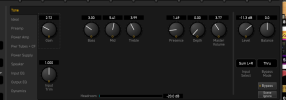You are in interesting territory. In the Marshall collectors' world, Plexis stopped being made in 1969, when they moved over to metal control panels instead of "plexi-glass". A 1972 50 watt Marshall won't have been a "Plexi", and there were a lot of different 50 watt Marshall amp models made in 1972. Model 1987 was the 50 watt lead guitar head that carried over, but model 1986 (50W bass head) was all but identical, and continued with the same circuit design at least until 1977, maybe even 1978.
The specific amp model designs changed in pretty subtle ways, with many of the myths around higher gain amps probably having as much to do with pot tapers as any internal specification changes. There is also some confusion around US versions vs. rest of world. The designs of individual models never seem to have changed all that much, but they were moving from turret board amps to PCBs in the 70s, and the suppliers of capacitors were competing for price with new materials. Similarly carbon film resistors replaced carbon composite resistors during the amps' development period. Some believe these changes contributed to changes in the perceived "tone" of the amps.
It would be hard to say that Marshall tweaked for more gain over the years, but it does seem they wanted the amps to sound very loud when the volume control was set fairly low. I'm sure not many in 1972 tried full volume on a 100 watt Marshall into a 4x12, becuase they are pretty much deafening before the volume control gets to 2. Attenuators and power soaks were pretty much unheard of back then, and before 1975/6, there weren't any "Master Volume" amps produced by Marshall themselves.
You're not crazy. Not sure about tighter, but in Fractal world the Plexis do indeed sound more percussive once driven fairly hard. The lack of master volume (or set to 10 in ideal controls) means that once the input volume is set to get in the slightest crunchy, the power amp supply is starting to sag a bit, and the natural compression of this gives a load more percussive pick attack than the 2203/2204 models.
What you have to remember is that the 2204 (and to an extent the 2203, but, my god, they are both still loud!) the tones are achievable at "loud" rehearsal room or pub gig level. Driving a 100 watt 1959 Plexi with humbucking guitar pickups with the volume at 3 or 4 into a 4x12 (or 2 of them) is ridiculously loud even in a 200 seat venue. So yes, capable of of some things we never expected of the master volume Marshalls, but it was rare to be in a big enough room to exploit the way they sounded best for mere mortals.
(Back in 1989 or 90 I was told my stage volume level was "ridiculously loud" when sound-checking at Brixton Academy. I was using a plexi-reissue JTM45 1962 "Bluesbreaker", admittedly cranked up. At the time the venue held about 3000 people, and was reputed to be the largest indoor stage in Europe. The real problem was most likely that there was a lot of guitar in the backfold/sidefold, and it was coming out through front of house. Point remains, Marshalls sound good when played quite a bit louder than people are expecting. It's hard to appreciate that when listening to a model through headphones or studio monitors, as large movements of air are part of the overall experience.)
Liam

